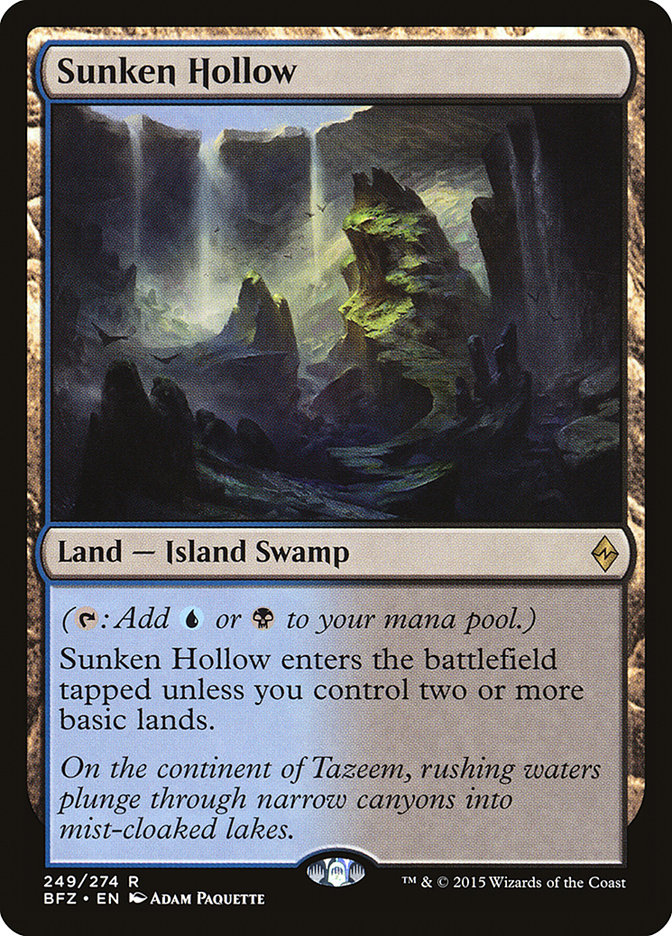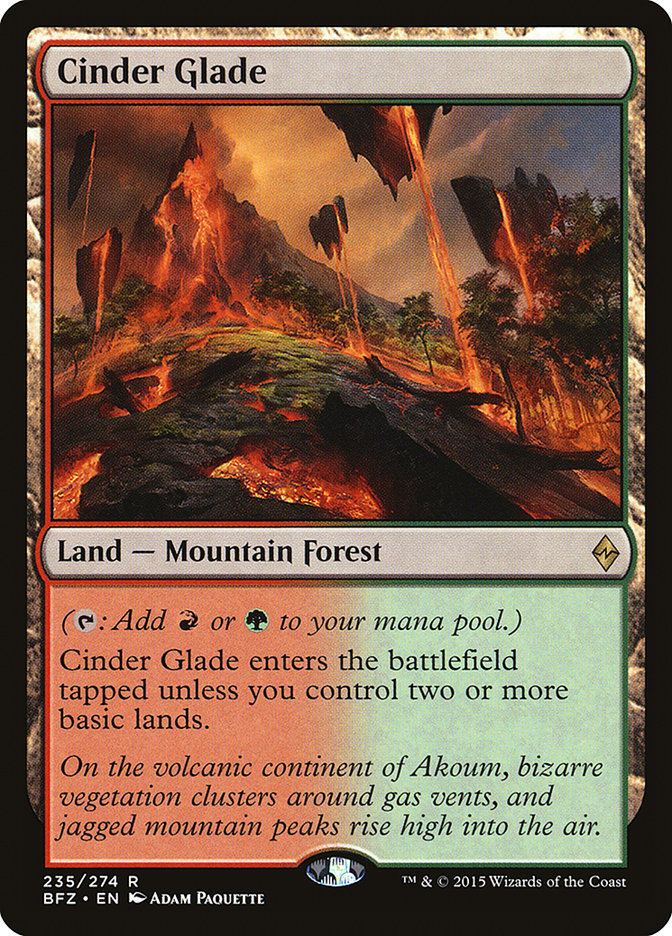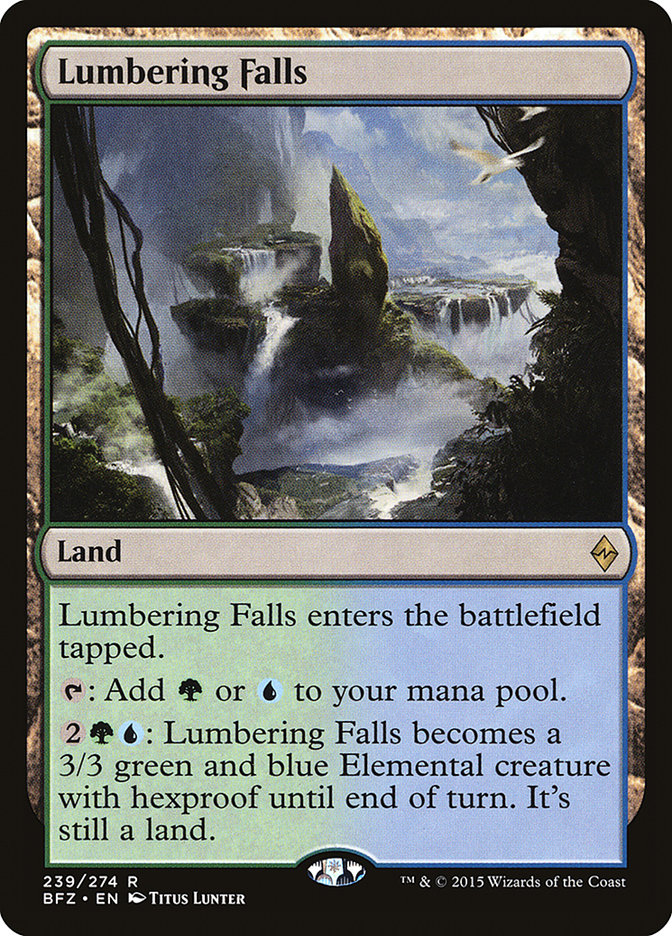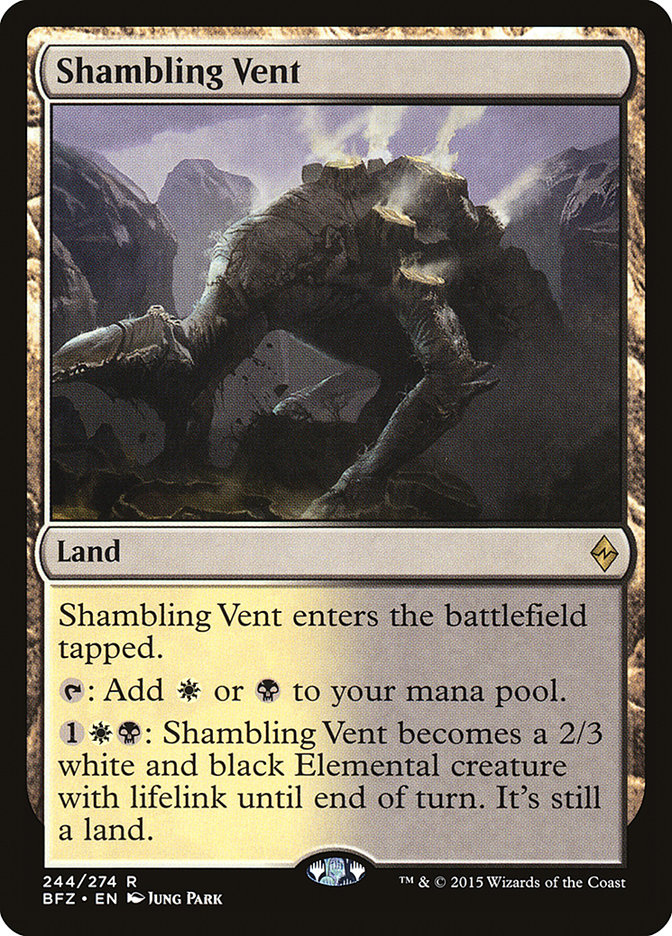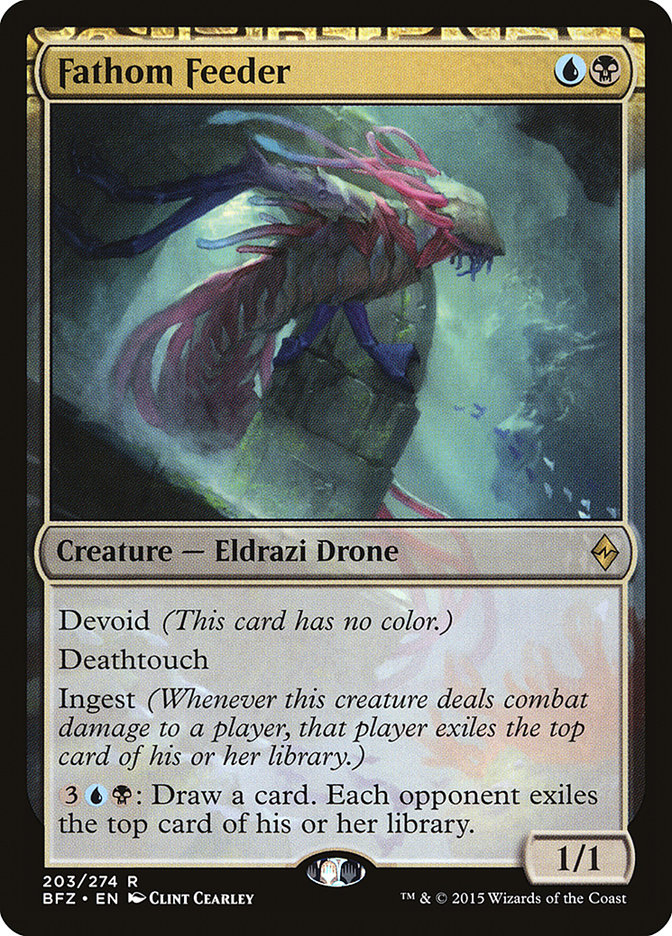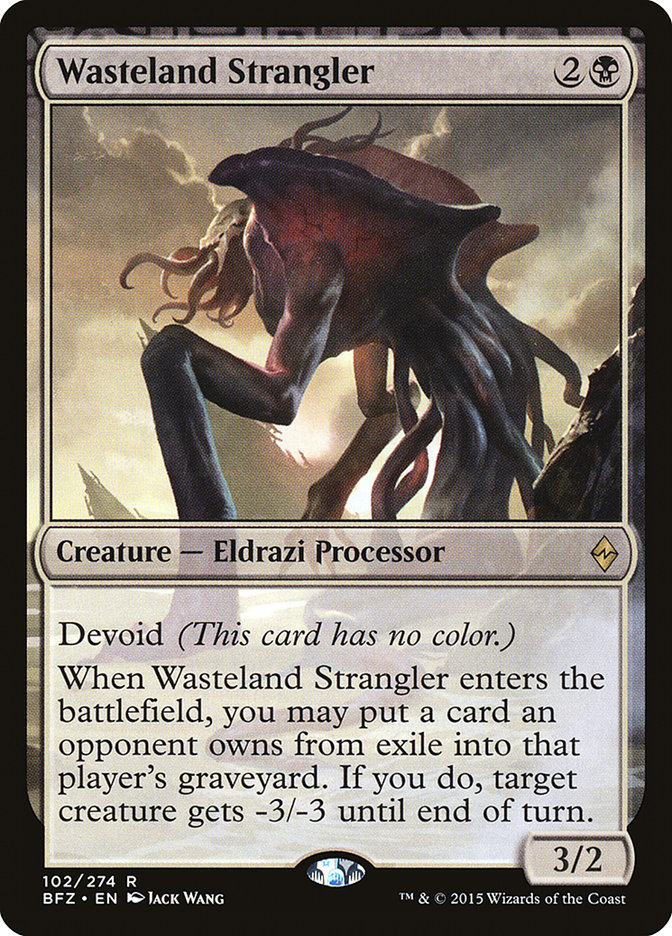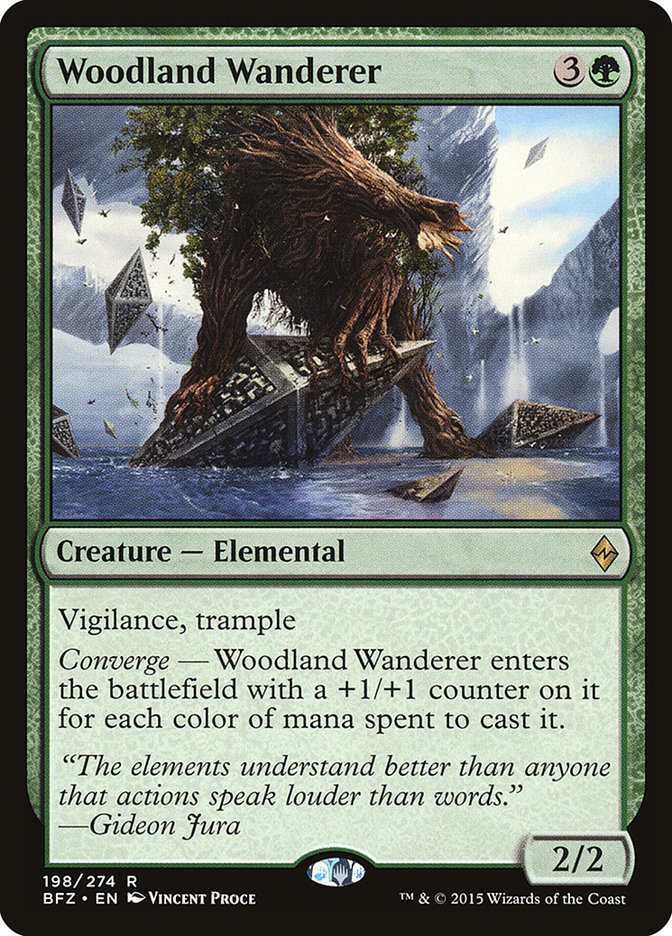This spoiler season, I’ve been a little busier than usual, thanks to my wedding last weekend. I haven’t kept up with all of the card reveals nearly
as closely as usual, so when the full spoiler for Battle for Zendikar was finally posted, far more of the set was a surprise to me. In a way, I
kind of like this sort of experience since it affords an opportunity to look at things more holistically, as well as more of a single big moment of
discovery.
While I hadn’t kept up with all of the cards as they were revealed, I was aware of the general tone of people talking about the set on social media. From
what I could tell, many people seemed to be unimpressed at best with many of the new cards, and my initial impressions were the same. It was hard to bring
myself to be excited about a major new mechanic that basically just pretended some cards didn’t have colored mana symbols in their costs, or about another
one that treated the exiled zone as a kind of second graveyard.
That said, while the overarching themes of the Eldrazi weren’t particularly compelling to me, there are still quite a few individual cards in the set that
caught my eye, and that’s what I want to talk about today. So let’s get to it!
Perhaps the most important cards in Battle for Zendikar are the Battle land cycle. In some ways, Prairie Stream and friends are the second coming
of the Ravnica shocklands. They’re not as effective in decks packed full of them since they require basic lands to enter the battlefield untapped,
and they’re never going to be as good in decks that really need their mana in the early turns of the game. But since they have land types like the
shocklands, they can be used in the same way alongside fetchlands in order to easily splash additional colors in almost any deck.
Thanks to the Temples, tri-lands, and fetchlands, Standard has been a pretty multicolor friendly format for a while now, but the introduction of these new
lands may very well break things wide open. With just the Ravnica shocklands and the occasional Farseek to fetch them, Standard saw three, four,
and even five-color decks all over the place, with both Kessig Wolf Run and Nephalia Drownyard showing up in Bant decks as win conditions. With fetchlands
and Battle lands, splashing an additional color may become almost trivial, especially for cards aimed toward the lategame.
That said, the new lands will make for an interesting balancing act when actually constructing manabases. Many multicolor decks historically tend to be
jammed full of as many non-basic lands as possible, with perhaps a few basics thanks to the inclusion of fetchlands. But with the new Battle lands, players
will have to bias their decks toward basic lands in order to ensure that they are able to consistently have two or more on the battlefield by the early to
middle turns of the game. This will certainly increase the popularity of fetchlands since even off-color fetches can still get one of your basic land types
in addition to your Battle lands. I can even imagine five-color decks that literally just play one of each basic, one of each Battle land, and a whole
bunch of fetches. That’s probably not the optimal way to construct a manabase, but it’s a start.
Regardless of the optimal way to use them, it’s important to recognize that these cards are the single most important addition to Standard from Battle for Zendikar. What the mana in a format allows is the bedrock of all deckbuilding, and these new lands completely transform what is
possible. As long as both the Battle lands and the fetchlands are in Standard at the same time, it’s going to be a truly wild ride.
The creature-lands from Worldwake had a huge impact on Standard, with all but Lavaclaw Reaches regularly seeing play even in Modern to this day.
The two new opposing color versions that Battle for Zendikar introduces don’t immediately stand out as being quite as impactful as their
ancestors, but any card that can serve as both resource and win condition should not be overlooked.
Of the two, I’m more immediately excited about the potential of Shambling Vent. A B/W dual land that offers long game value can immediately slot into the
Abzan shells that are already quite powerful. While a 2/3 body isn’t going to end games quickly, lifelink is a very strong effect that can help turn a game
around. In many cases, decks like Abzan can find themselves in a topdecking war against aggressive red decks (which are always popular around rotation
time), trying to find a Siege Rhino before the opponent draws the last lethal burn spell. Shambling Vent can completely alter that dynamic, forcing the
opponent to keep removal in reserve or risk the lifelinking land taking the game out of reach. This not only constrains the red player’s use of their
cards, but also of their mana, which is all the more of an issue with Stoke the Flames gone and replaced by the sorcery speed Exquisite Firecraft.
Lumbering Falls is a card that seems excellent in control mirror matches. Historically, lands have proven to be excellent threats in such matchups, thanks
to both their lack of a mana cost to play and their inability to be countered. Lumbering Falls takes things one step further and adds hexproof to the deal,
making it a virtually unstoppable threat in a world where blockers are scarce. That slipperiness does not come without a cost, though. Lumbering Falls is
quite inefficient in terms of its size compared to its activation, clocking in at just a 3/3 body for four mana. Still, in a matchup that comes down to
lining up threats and answers over a long period, it’s hard to beat a creature-land that dodges most removal altogether.
While the Worldwake creature-lands were staples in essentially every deck that used the appropriate colors, I expect these new versions to be
significantly less popular. Their biggest drawback is how they interact with the new Battle lands, which I expect to be core inclusions in many decks.
While the old creature-lands came at the price of entering the battlefield tapped, these new ones have the additional cost of making your Battle lands much
more likely to also enter the battlefield tapped. I think that will be a price worth paying in many cases, but it’s important to keep in mind that it is
very much a real cost that will keep these from being four-ofs in every deck sporting those colors.
Ingest and the various cards that use the opponent’s exile zone as a resource are some of the toughest things to evaluate in Battle for Zendikar
because they don’t line up easily with previous methods of evaluating cards. But in scouring the spoiler, these were two of the cards that stood out to me
as the most exciting uses of the mechanics, both as enablers and payoff.
Fathom Feeder is somewhat innocuous since it’s just a 1/1 deathtouch for two mana. But as a two drop with ingest, it can help feed into your effects that
require exiled cards early on. Deathtouch means your opponent can’t just easily block and kill it, and it’s additional card draw plus exile ability ensures
that it can continue to have an impact even in the lategame. That’s a lot of action for just two mana, and frankly that many abilities on one cheap card
tends to mean that it’s pushed by development for a reason. I have a feeling that Fathom Feeder will be a cornerstone of decks that use the ingest/exile
mechanics.
As to what Fathom Feeder is, well, feeding, Wasteland Strangler and Ulamog’s Nullfier seem like good places to start. Wasteland Strangler is reminiscent of
Skinrender, which was an exceptionally powerful card in any creature-based matchup during its time in Standard. Of course, that Standard was full of Jace
the Mind Sculptor and Primeval Titans, which made it a much less creature friendly environment, leaving Skinrender relegated to sideboards. Wasteland
Strangler is much more likely to find victims in today’s Standard, with even control orientated decks playing creatures like Nissa and Jace.
Ulamog’s Nullifier is a similarly powerful tempo play, though one that is clearly better against decks playing more expensive cards. It’s basically a
flying conditional Mystic Snake, which is a powerful effect in the right context. Thankfully, Siege Rhino is altogether quite likely to be a major player
in Standard for a long time, and it’s a lovely target for a Nullfier. If decks tend to be even more ramp oriented to take advantage of the Eldrazi and the
like, Ulamog’s Nullifier will have even more potential victims of huge tempo swings.
It’s important to keep in mind that Ingest isn’t the only way to feed the Stranglers and Nullifiers of the world. Every effect that exiles something helps
provide fuel for the Eldrazi machine, from Abzan Charm to Utter End and many more. It’ll be interesting to see if this proliferation of exile effects
causes Hangarback Walker’s stock to drop, since a world full of people trying to feed their Eldrazi is much less friendly to death triggers.
Speaking of exile effects, this is a very powerful one that stands out on the spoiler to me. If you’re playing a deck full of colorless fatties, this is
effectively an Abzan Charm that can hit anything, and it has a much more forgiving mana cost.
Titan’s Presence fills multiple roles in a deck that’s looking to use the Eldrazi. It’s obviously a strong removal spell, but because it exiles the
creature, it also happens to fuel things like Ulamog’s Nullifier and Wasteland Strangler. It has the feeling of a key cog in the Eldrazi machine, wiping
out their enemies and using their remains to fuel their future conquest.
It’s important to keep in mind that Titan’s Presence works not only with the big colorless cost Eldrazi like Ulamog but also with all of the colored cards
in the set with devoid. It’s really awkward to search for all of them at once in any of the available card databases, but cards like Sire of Stagnation and
Smothering Abomination work just as well as Oblivion Sower and Ulamog itself, although perhaps not as well against other huge creatures.
It’s also worth noting that the purely colorless cost of Titan’s Presence makes it a meaningful spell that you can cast off of something like Hedron
Archive. Being able to both double ramp and interact in the same turn is a big deal, especially in a deck that’s trying to get to truly huge spells.
It seems like there may well be enough tools to put together a legitimate Ingest/Eldrazi deck, and Titan’s Presence is almost certainly a key part of that.
It’ll be one of the most difficult decks to tune in a short window since it’s so unlike anything we’ve seen before, but I have hope that it will become a
real contender.
Speaking of things I hope will find a place in Standard, these two mark the dynamic duo of new green creatures that really caught my eye. With Elvish
Mystic gone, green really needs some strong midrange bodies to fill the void, and these two certainly seem like they’ll deliver.
Woodland Wanderer is just a collection of raw numbers and abilities, and one that fits perfectly into the many-colored world the new Battle plus fetch
manabases seem poised to create. A potential 6/6 for four different colors of mana – with vigilance and trample no less – is a really good deal. But it’s
also great that in a pinch the Wanderer can be played at less than its full size. Unlike a card that actually requires four different colors to cast,
Woodland Wanderer can come down as an only marginally worse 5/5 for four if your lands don’t happen to cooperate – and that’s a pretty big deal.
Undergrowth Champion is also a card that wants to be played in a fetchland-heavy manabase, though it needs a little more commitment to green. Double color
costs are actually non-trivial when you’re trying to build around fetches and Battle lands, since it makes it harder to support as diverse a range of
costs. While the Wanderer could easily fit into a deck with Mantis Rider, for instance, it’s going to be a lot harder to cast Undergrowth Champion in the
same deck, since 1GG and URW are very difficult costs to manage off of the same basic lands.
The Champion, however, threatens to get truly huge, and once it does, is nearly impossible to kill outside of direct removal. Even in the earlygame, you
can use the same tactic against direct damage as is currently used to protect a Nissa that’s about to flip. Play the Champion and then immediately trigger
it with a fetchland, so if your opponent tries to respond to the trigger with a burn spell, you can immediately sac the fetch for a +1/+1 counter to save
it.
Undergrowth Champion is an excellent card for midrange strategies that want a meaningful threat early on that can still compete in the lategame. It feels
like a Knight of the Reliquary in many ways, except without the utility or immediate lategame impact. It’s surely worse, but there’s a lot of room for a
card to be weaker than Knight of the Reliquary and still be very good.
Gideon is probably the most straightforward powerful new card in the set, so I feel like I’d be remiss to leave him out. All three of Gideon’s abilities
are great and work very well together. I have hope that maybe the departure of Sylvan Caryatid and Courser of Kruphix along with the arrival of Gideon may
reinvigorate aggressive white decks, for which Gideon represents a constant stream of creatures, a potential permanent boost to your team, and a threat
that survives sweepers – literally everything such a deck typically wants.
One thing that’s easy to miss is the fact that the creatures Gideon creates are Allies. That’s sort of a theme of Allies in this set, it seems – being easy
to overlook. It’s hard to tell which creatures are Allies and which are not, but those that take advantage of the tag will certainly want to go to battle
alongside Gideon since he can trigger their abilities every turn without any additional investment on your part.
One non-Ally that I’m certainly looking forward to trying alongside Gideon is Wingmate Roc. The bird buddies that once dominated Abzan mirrors fell out of
favor with the printing of Languish, but Gideon’s ability to creature a permanent anthem effect that isn’t vulnerable to opposing removal can help take the
fliers out of range of the sweeper. With Elspeth gone, there is no longer a drawback to reaching four power, so boosting the birds to 4/5 helps them
dominate the skies. Gideon can also use his other two abilities to help trigger raid, whether by calling on his buddies or heading into the fray himself.
All told, while Battle for Zendikar may not have as many obviously powerful and awesome cards as sets like Khans or Dragons of Tarkir, I have faith that there are quite a few hidden gems among the lot. The set’s mechanics will take quite a bit more exploration
to gauge their power than cards like Siege Rhino, Mantis Rider, or Dragonlord Atarka. And isn’t that exploration exactly what makes Magic so fun?
What do you think? What are the standout cards in Battle for Zendikar? What do you think will be the set’s hidden gems?

